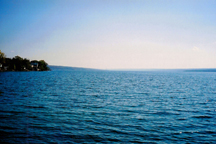The Finger Lakes are glacially formed lakes in upstate New York, mainly linear in shape, each lake oriented on a north-south axis. The longest, Cayuga Lake, is 40 miles from end to end, but never more than 3.5 miles wide and not atypical in shape, reminding early map-makers of the fingers of a hand. Considering their narrow width, both Cayuga and Seneca Lakes have a remarkable trait; they rival much larger Lake Ontario for depth, each more than 400 feet.
The Finger Lakes
The 11 Finger Lakes from east to west:
Otisco Lake, Skaneateles Lake, Owasco Lake, Cayuga Lake, Seneca Lake, Keuka Lake, Canandaigua Lake, Honeoye Lake, Canadice Lake, Hemlock Lake, and Conesus Lake.
Oneida Lake, to the northeast of Syracuse, New York, is sometimes included as the "thumb," although it is shallow and somewhat different in character from the rest. Onondaga Lake, though located just north of the Finger Lakes region, is not considered one of the Finger Lakes. Conesus, Hemlock, Canadice, Honeoye, and Otisco are considered the minor Finger Lakes. Other, smaller lakes, including Silver, Waneta, and Lamoka Lakes, dot this region.
The Finger Lakes Region
Roughly the western half of the Finger Lakes region comprised the Phelps and Gorham Purchase of 1790, the largest land purchase in the world to that date. The Finger Lakes region, together with the Genesee Country of Western New York, has been referred to as the Burned-Over District, where, in the 19th century, the Second Great Awakening was a revival of Christianity, and some new religions were also formed.
The Finger Lakes region is an important agricultural belt of New York. The state land grant institution is Cornell University. Its alma mater begins "Far Above Cayuga's Waters", because it is on the hills overlooking the city of Ithaca and the southern end of Cayuga Lake. Cornell also maintains the New York State Agricultural Experiment Station and horticultural gene bank at Geneva on the north end of Seneca Lake.
The rolling land between the lakes is occupied with dairy farms, many of them owned by Amish and Mennonite families. These farms raise corn, hay, wheat, oats, barley, and soybeans. Cabbages, sweetcorn, and potatoes are major vegetable crops. Maple syrup and honey are also local products.
Especially around Keuka Lake and the south ends of both Canandaigua and Seneca Lakes are many vineyards and wineries where one can often taste the wines before purchasing them. Most of the area was originally forested with oak, maple, chestnut, ash, hemlock, and beech trees, but the Iroquois maintained, by annual burning, the land between Cayuga and Seneca Lakes as prairie, with herds of bison, normally thought of as a western animal. Today the Finger Lakes area is still known for fishing and hunting. Winter sports are also popular, with skiing, snowmobling and ice fishing available.
The southern ends of the lakes are characterized by steeper hills and glacial hanging valleys which are tributaries that drop steeply to the lake, often with waterfalls. Taughannock Falls State Park, Fillmore Glen, and Watkins Glen are especially scenic examples that have been made into parks. The Village of Watkins Glen is a producer of table salt and the site of an auto racing course.
NEXT
The above information uses content from the English Wikipedia. The original Finger Lakes content was at wikipedia: Finger Lakes and the Cayuga Lakes content was at: Wikipedia: Cayuga Lake. The list of authors can be seen in the Finger Lakes History and the Cayuga Lake History . Thisa content of Wikipedia is available under the GNU Free Documentation License.






